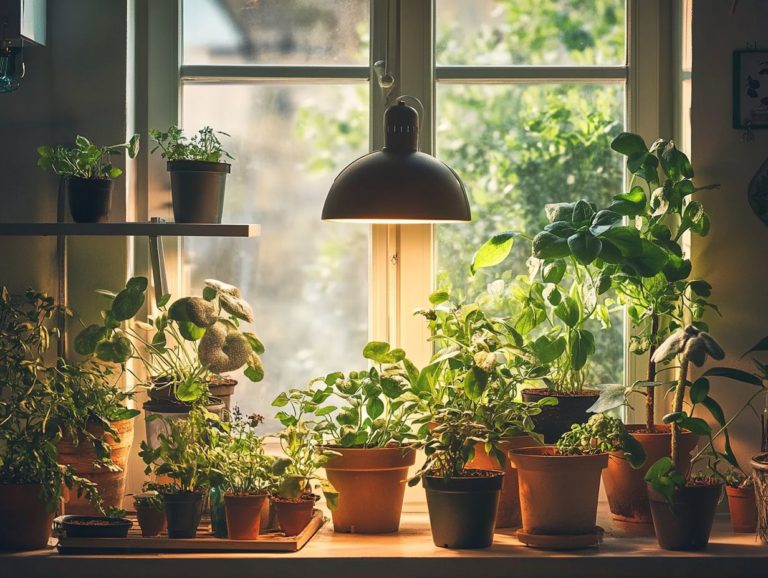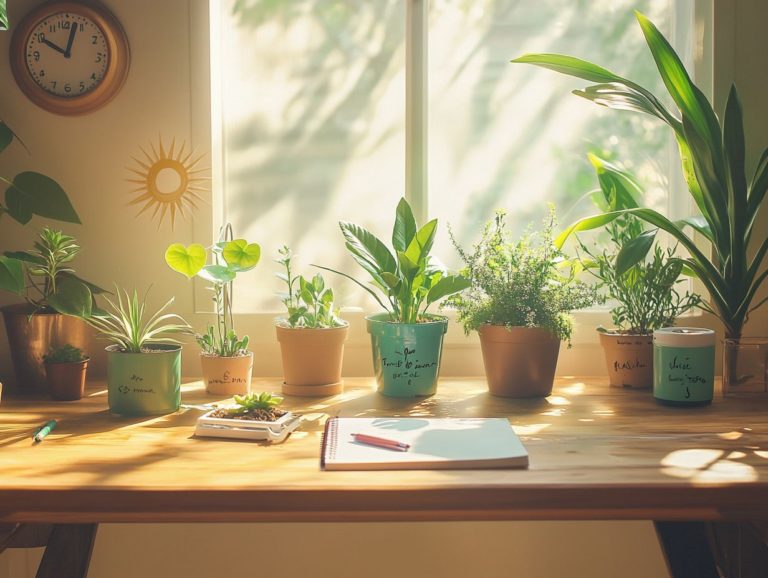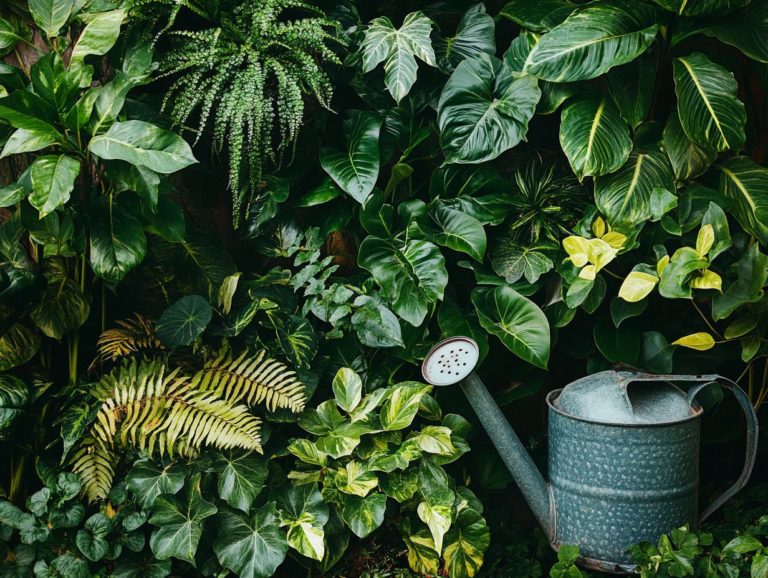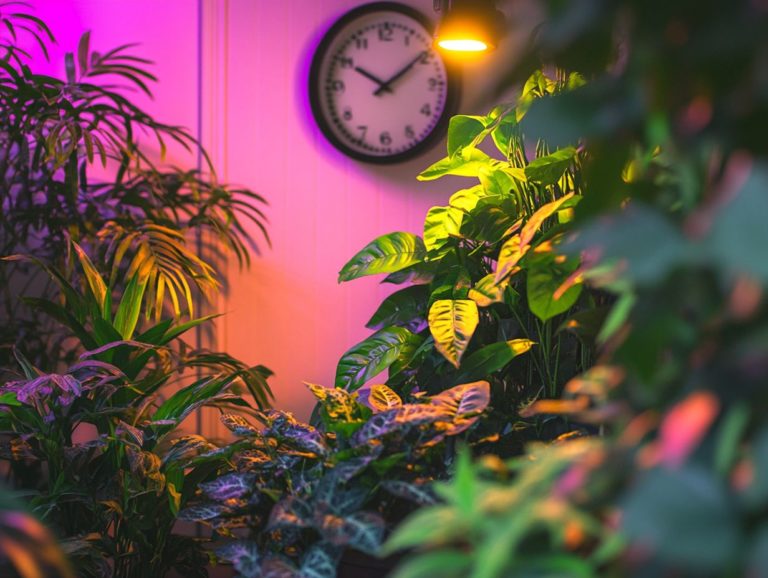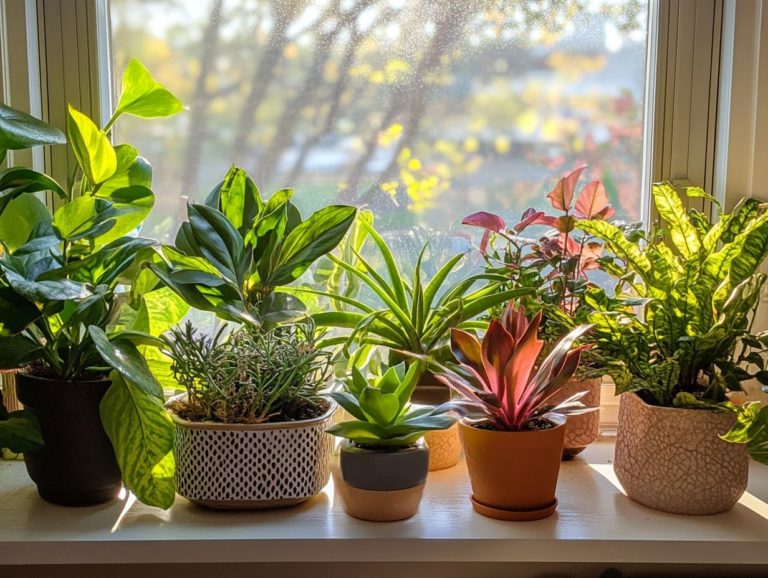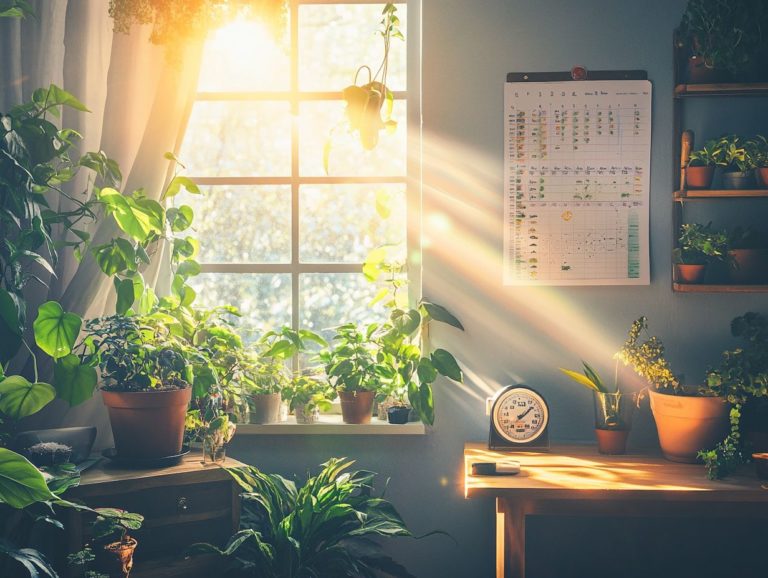Understanding the Light Spectrum for Plants
Light is more than a source of illumination. It s essential for the growth and vitality of your plants.
This article explores the crucial role light plays in photosynthesis. We ll simplify the light spectrum and its varying wavelengths.
We will discuss other vital growth elements. You ll learn how to choose the right lighting for your indoor and outdoor gardens.
Let s dive in and uncover the secrets of plant lighting!
Contents
- Key Takeaways:
- The Importance of Light for Plant Growth
- The Light Spectrum and Its Components
- Red and Blue Light: Their Effects on Plants
- Green Light and Its Role in Plant Growth
- Other Factors Affecting Plant Growth
- Choosing the Right Light for Your Plants
- Frequently Asked Questions
- What is the light spectrum and why is it important for plants?
- What are the different colors in the light spectrum and how do they affect plants?
- How can I measure the light spectrum for my plants?
- Can plants grow without certain colors in the light spectrum?
- How can I provide the right light spectrum for my plants?
- Are there any plants that require a specific light spectrum to grow?
Key Takeaways:

- Light is essential for plant growth, as it helps plants produce food through photosynthesis.
- Red and blue light are the most important for plant growth, while green light also has benefits.
- Don t ignore green light; it can also assist in photosynthesis and should be included in your light sources.
The Importance of Light for Plant Growth
The significance of light for plant growth is paramount, serving as the lifeblood of photosynthesis the process where plants transform light energy into chemical energy, driving their growth and development.
You should recognize that adequate light, especially within the photosynthetically active radiation (PAR) range, is vital for optimal chlorophyll activity. This affects everything from plant morphology to overall yield.
In your indoor gardening and horticulture endeavors, the selection of grow lights plays a critical role in determining light quality, intensity, and spectral distribution. This choice directly influences the health and productivity of your plants, regardless of the environmental conditions you re working with.
Role of Light in Photosynthesis
The role of light in photosynthesis is absolutely crucial, serving as the energy source that enables you to transform carbon dioxide and water into glucose and oxygen essential for your growth and survival.
This intricate biochemical process unfolds primarily in the chloroplasts, where the chlorophyll pigment expertly captures light energy, particularly from the blue and red wavelengths. This optimizes absorption for photosynthesis. Once this energy is absorbed, it catalyzes the conversion of light into chemical energy, triggering a series of reactions that culminate in glucose synthesis. This sugar not only fuels your development but also shapes various morphological traits, influencing aspects like leaf size, stem strength, and overall biomass.
Different light wavelengths play significant roles in maximizing photosynthetic efficiency. For example, red light promotes flowering, while blue light is vital for vegetative growth. These elements come together to enhance your adaptability in diverse environments, ensuring you thrive wherever you are planted.
The Light Spectrum and Its Components
The light spectrum encompasses a fascinating range of electromagnetic radiation frequencies, each with unique wavelengths that can profoundly impact plant growth and health. Grasping the intricacies of these components is essential for achieving excellence in horticulture.
Understanding the Different Wavelengths
Understanding the various wavelengths of light is essential for optimizing your plant growth conditions. Each wavelength elicits distinct responses from plants, influencing their growth cycles and flowering stages.
Take blue light, for example; it s fundamental for promoting chlorophyll production, which boosts photosynthesis and encourages vigorous vegetative growth. Conversely, red light plays a critical role in triggering phototropic responses, helping plants grow toward light sources to maximize their light absorption. Specific wavelengths of red light are particularly important for initiating flowering in numerous species, ensuring they bloom at just the right moment.
To achieve robust plant health, utilizing full-spectrum light is key. This comprehensive lighting approach not only fosters growth and flowering but also enhances plants’ resilience against pests and diseases.
Red and Blue Light: Their Effects on Plants
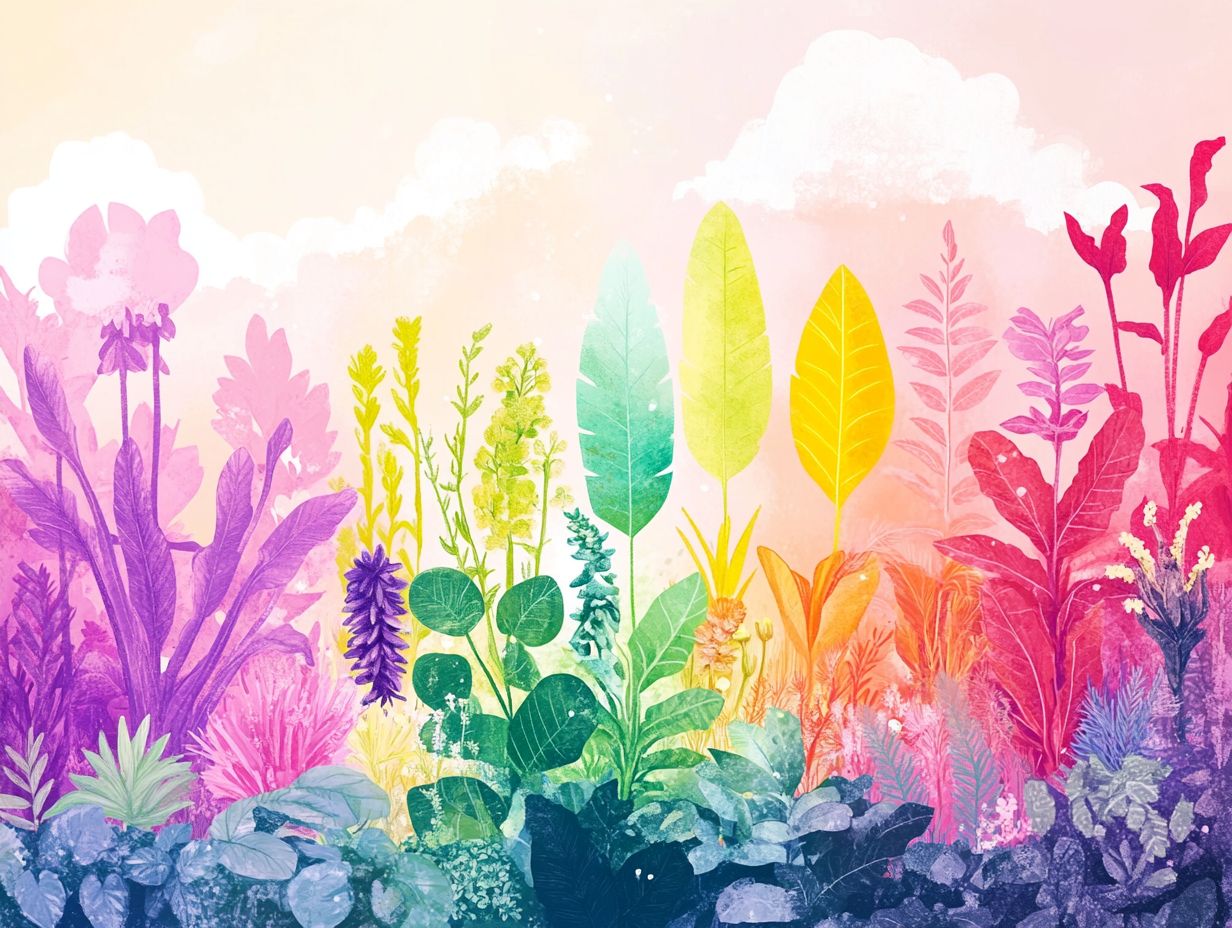
Red and blue light are essential for your plants’ growth and development. They significantly influence how plants use light and the efficiency of chlorophyll</b the green pigment in plants that helps them absorb light. This interplay is crucial for ensuring optimal plant health and vitality.
How Plants Use Light
Different wavelengths of light effectively drive photosynthesis, highlighting the importance of light quality in achieving robust plant growth.
When you explore these wavelengths, you ll find that chlorophyll absorbs light most efficiently in the blue range (around 430-450 nm) and the red range (approximately 640-680 nm). This information is especially valuable for indoor gardening and horticulture, where access to natural light may be limited.
Use this knowledge to choose lighting systems, such as LED grow lights, that emit light at these crucial wavelengths. By optimizing light quality, you not only enhance photosynthesis but also promote robust growth patterns, encourage flowering, and maximize yields essential elements of successful plant cultivation.
Green Light and Its Role in Plant Growth
You may not realize it, but green light, often overlooked in discussions about plant growth, plays a unique and significant role in shaping plant structure.
It can even affect light absorption efficiency, challenging common myths about its effectiveness.
Debunking the Myth of Green Light
Understanding the benefits of green light opens the door to its remarkable advantages in plant development, particularly in enhancing light quality for overall growth.
Recent studies show that green light plays a crucial role in photosynthesis, a fact often ignored in traditional horticultural practices. Contrary to the belief that plants primarily absorb red and blue wavelengths, research indicates that green light penetrates deeper into leaf layers. This deeper penetration helps in regulating biomass accumulation and boosting chlorophyll production.
Incorporating green light into your modern lighting systems can significantly improve plant health and increase yields. This approach optimizes the full spectrum of light necessary for essential metabolic processes. By reevaluating how plants utilize this spectrum, you can refine your cultivation strategies, paving the way for more sustainable and productive farming practices.
Other Factors Affecting Plant Growth
While light is undeniably critical for plant growth, various other factors like temperature, humidity, and light intensity also play essential roles in shaping the environmental conditions that influence overall plant health and productivity.
Each of these elements contributes to the vibrant ecosystem that nurtures your plants, ensuring they thrive in their environment.
Temperature, Humidity, and Light Intensity

Temperature, humidity, and light intensity are interconnected factors that profoundly impact growth rates and crop yields. Diligent monitoring of these elements is essential in your horticultural practices.
Each factor plays a vital role in regulating enzymatic activities, nutrient uptake, and the overall metabolism of your plants. For example, maintaining an optimal temperature range enhances cellular respiration and photosynthesis, while proper humidity levels help prevent stress and disease. Light intensity is equally crucial, as it directly influences chlorophyll production, which is essential for converting sunlight into energy.
You can use tools like thermometers, hygrometers, and light meters to effectively monitor these conditions. Employ techniques such as shading, misting, or adjusting ventilation to fine-tune the environment, ultimately fostering healthier plants and yielding more bountiful harvests.
Don t miss out on the chance to boost your plants’ health! Explore more tips to enhance your gardening success!
Choosing the Right Light for Your Plants
Choosing the right light for your plants is crucial for optimal growth and health. The right grow lights can transform your garden into a thriving paradise.
Considerations for Indoor and Outdoor Growing
When deciding between indoor gardening and outdoor growing, consider the light sources that best suit your plants. The type of grow lights you choose should fit the needs of your plants based on their light preferences.
Understanding how light affects plant health is essential. Indoor plants flourish under artificial grow lights, especially when natural sunlight is limited.
Outdoor plants thrive best in direct sunlight for most of the day. Factors like the type of plant, the season, and your geographic location are crucial for determining light needs.
To maximize indoor growth, adjust the intensity and duration of light exposure using timers or movable fixtures. For outdoor gardening, select your planting location carefully to optimize sun exposure.
Frequently Asked Questions
What is the light spectrum and why is it important for plants?
The light spectrum is the range of wavelengths that plants can absorb for photosynthesis. This energy helps plants produce food and grow. Different wavelengths affect plant growth and development differently. Chlorophyll is vital for absorbing light energy and influencing plant responses.
What are the different colors in the light spectrum and how do they affect plants?
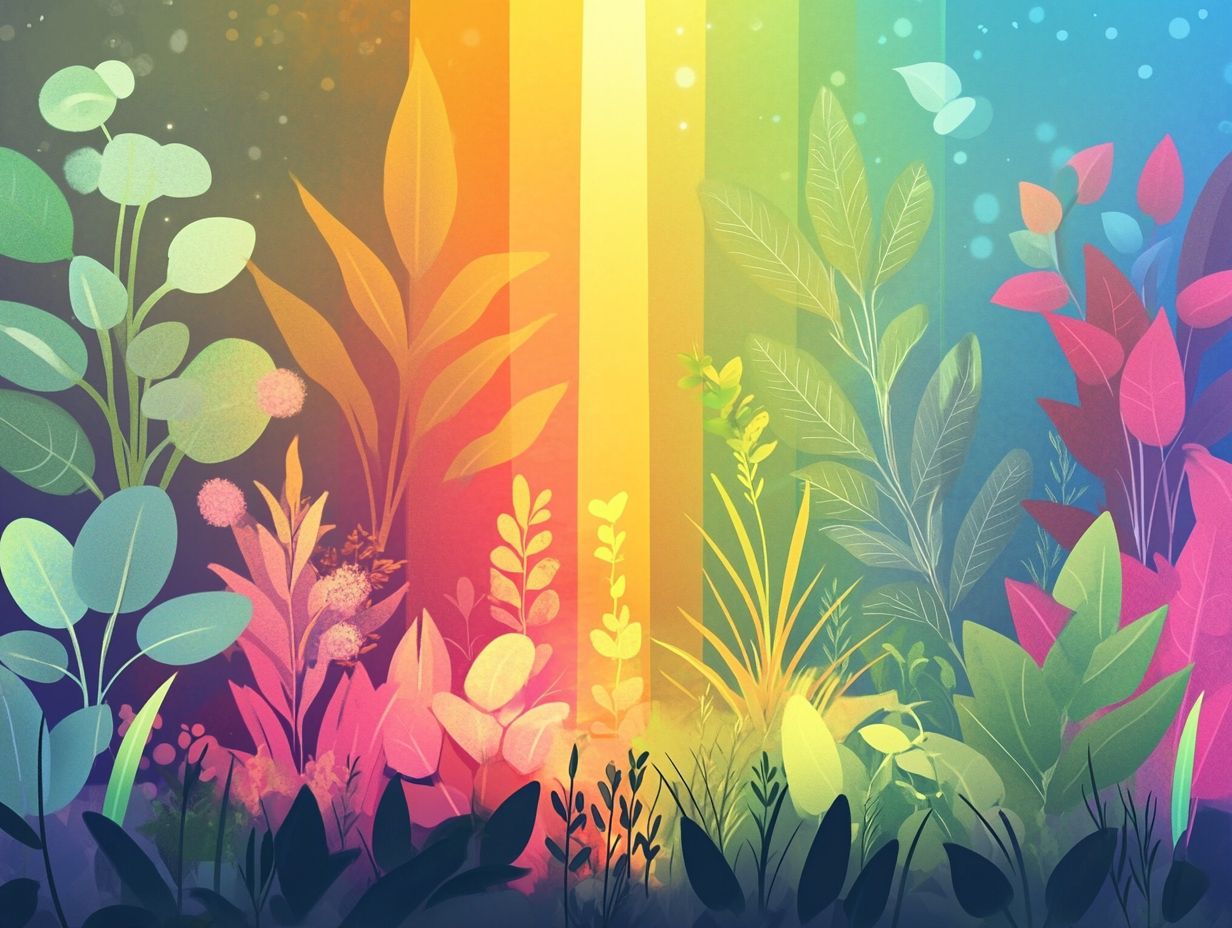
The colors in the light spectrum include red, blue, green, yellow, orange, and violet. Each color has a different wavelength and impacts plant growth in unique ways. Red light promotes flowering and fruiting, while blue light is essential for vegetative growth. UVA and UVB light also play a significant role in shaping plant growth and nutrient supply.
How can I measure the light spectrum for my plants?
To measure the light spectrum, use tools like a spectrometer, colorimeter, or light meter. These devices help you understand the intensity and colors of light your plants receive, which is vital for their health.
Can plants grow without certain colors in the light spectrum?
Yes, plants can grow without some colors, but their growth may slow down. For instance, plants under red light might not grow as tall as those under a full spectrum.
How can I provide the right light spectrum for my plants?
Use a mix of natural sunlight and artificial grow lights to give your plants the right spectrum. Adjust the distance and duration of light exposure to meet their needs.
Are there any plants that require a specific light spectrum to grow?
Yes! Some plants, like flowering ones, need more red light, while leafy vegetables thrive on blue light. Researching specific plant needs is crucial to avoid nutrient deficiencies and ensure strong growth.

